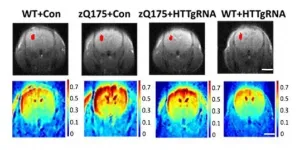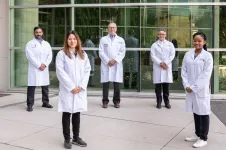Wild birds learn to avoid distasteful prey by watching others
2021-07-07
(Press-News.org) How do predators know to avoid brightly-coloured toxic prey? A collaboration of researchers has put social information theory to the test in a reliable real-world system to find the answer - by copying what others do, or do not, eat.
An international team of researchers from Finland, New Zealand, Colombia and the U.K. have provided the first evidence that wild birds can learn to avoid distasteful prey by observing what others eat.
"We've known for a long time that predators, like birds, associate brightly coloured warning signals with the danger of eating certain prey types. However, we've never been able to demonstrate in the wild how predators learn about these aposematic prey advertisements. If predators do not recognize the signal, then the prey are highly vulnerable to naive predators. This is a big problem that prey face each year when juvenile predators arrive. Since aposematism is widespread in nature, we wanted to solve this problem in a real-world setting" explains one of the lead-authors Rose Thorogood, now at the University of Helsinki.
At the established Madingley Wood field site in Cambridgeshire, UK, Liisa Hamalainen, a doctoral student at the University of Cambridge, used an innovative combination of field experiments and social network analyses to investigate the capacity for social information transmission among bird predators and identified potential implications for predator-prey coevolution. The team's results offer solutions to evolutionary problems in predator-prey dynamics and support theoretical predictions from social learning theory. But more broadly, the research speaks to the role of social information amidst the powerful dynamics of ecology and evolution, and hence opens the door to new studies in other coevolutionary systems.
According to this experiment, one avenue is through social learning. The researchers set up pairs of bird-feeders within the Madingley Wood field site. One feeder would dispense brightly-dyed almond flakes that were left naturally tasty (undefended prey). The other would dispense differently-coloured almond flakes with additives to make them disgustingly bitter (aposematic prey). Local blue tits (Cyanistes caeruleus) and great tits (Parus major) could gather around the feeders and take their pick of food, but also observe the feeding attempts of others.
In between the experimental sessions, the feeders dispensed plain, uncoloured almond flakes. During this time, the researchers used RFID to record predator visits to the feeders. Will Hoppitt, a statistical consultant from Royal Holloway University of London, then generated a social network based on the likelihood for individuals to forage together, and compared this to the patterns observed in the birds' choices of coloured almonds.
The analysis showed that birds could learn to avoid the bitter almonds within eight days, with adults being quicker to learn than the juveniles. Importantly, information about the bitter almonds appeared to flow through the predicted social links, especially from adults to juveniles. This offers a solution to the problem of naive predators, as they can learn by watching the behaviour of others instead of through trial-and-error. Thereby, the selection pressures exerted on their aposematic prey are reduced.
"These results greatly extend the current state of our knowledge gained from studying predator learning under controlled lab conditions. It demonstrates that social interactions both within and across species allow predators to learn very quickly, and in turn allow aposematic prey types to persist across naive predator generations. This highlights that social information transmission is likely to play a critical role in eco-evo dynamics and in many other coevolutionary systems, including host-parasite and plant-pollinator relationships. It's exciting to see what we can find from further field-based as we dive deeper into understanding the social layers of coevolutionary processes" Thorogood sums up.
INFORMATION:
The international collaboration was spearheaded by Liisa Hamalainen and Rose Thorogood at the University of Cambridge (now at Macquarie University and University of Helsinki, respectively), has recently published a pioneering insight into the networked social layer of eco-evo dynamics using a long-standing field system. The collaboration brings together expertise in social networks, coevolutionary dynamics, and fieldwork from across Europe.
This press release draws from the original text written by Stephen Heap (drstevilphd.com)
ELSE PRESS RELEASES FROM THIS DATE:
2021-07-07
Imagine a dust particle in a storm cloud, and you can get an idea of a neutron's insignificance compared to the magnitude of the molecule it inhabits.
But just as a dust mote might affect a cloud's track, a neutron can influence the energy of its molecule despite being less than one-millionth its size. And now physicists at MIT and elsewhere have successfully measured a neutron's tiny effect in a radioactive molecule.
The team has developed a new technique to produce and study short-lived radioactive molecules with neutron numbers they can precisely control. They hand-picked several isotopes of the same molecule, each with one more neutron than the next. When they measured each molecule's energy, they were able to detect small, nearly imperceptible changes of the nuclear ...
2021-07-07
BOSTON - The numbers of cancer screening tests rebounded sharply in the last quarter of 2020, following a dramatic decline in the first months of the COVID-19 pandemic, at one large hospital system in the Northeastern United States. These findings were released in a study published in Cancer Cell. The research also found an increase in racial and socioeconomic disparities among users of some screening tests during the pandemic.
Study co-senior author Toni K. Choueiri, MD, director of the Lank Center for Genitourinary Oncology at Dana-Farber Cancer Institute, said following a dramatic decline during the first pandemic peak, there was a "substantial increase in screening procedures during the more recent periods ...
2021-07-07
LAWRENCE -- A new paper appearing in Biology Letters describes the oldest-known fragmentary bat fossils from Asia, pushing back the evolutionary record for bats on that continent to the dawn of the Eocene and boosting the possibility that the bat family's "mysterious" origins someday might be traced to Asia.
A team based at the University of Kansas and China performed the fieldwork in the Junggar Basin -- a very remote sedimentary basin in northwest China -- to discover two fossil teeth belonging to two separate specimens of the bat, dubbed Altaynycteris aurora.
The new fossil specimens help scientists better understand ...
2021-07-07
Dutch-French research shows that Optical Genome Mapping (OGM) detects abnormalities in chromosomes and DNA very quickly, effectively and accurately. Sometimes even better than all existing techniques together, as they describe in two proof-of-concept studies published in the American Journal of Human Genetics. This new technique could radically change the existing workflow within cytogenetic laboratories.
Human hereditary material is stored in 46 chromosomes (23 pairs). Although those chromosomes are quite stable, changes in number or structure can still occur. A well-known example is Down syndrome, which is caused by an extra ...
2021-07-07
A decade's worth of data shows that neonatologists are shifting the type of respiratory support they utilize for preterm infants, a move that could lead to improved health outcomes.
Using two large national datasets that included more than 1 million preterm infants, researchers in a new Vanderbilt-led study found that from 2008 to 2018 there was a greater than 10% decrease in the use of mechanical ventilation for this patient population. Concurrently, there was a similar increase in the use of non-invasive respiratory support, such as continuous positive airway pressure (CPAP), for these infants.
The ...
2021-07-07
(Boston)--The discovery of novel groups or categories within diseases, organisms and biological processes and their organization into hierarchical relationships are important and recurrent pursuits in biology and medicine, which may help elucidate group-specific vulnerabilities and ultimately novel therapeutic interventions.
Now a new study introduces a novel computational methodology and an associated software tool called K2Taxonomer, which support the automated discovery and annotation of molecular classifications at multiple levels of resolution from high-throughput bulk and single cell 'omics' data. The study includes a case ...
2021-07-07
SILVER SPRING, Md.--Vaccines such as Pfizer, Moderna, Johnson & Johnson and AstraZeneca are designed to prevent severe Coronavirus-19 Disease (COVID-19) due to acute respiratory syndrome coronavirus 2 (SARS-CoV-2) and are highly efficacious. The efficacy is not different in people with and without obesity except for AstraZeneca which is not known, according to a new position statement from The Obesity Society (TOS), the leading scientific membership organization advancing the science-based understanding of the causes, consequences, prevention and treatment of obesity.
Trials have demonstrated high efficacy in individuals ...
2021-07-07
In a new study on mice, Johns Hopkins Medicine researchers report that using MRI scans to measure blood volume in the brain can serve as a noninvasive way to potentially track the progress of gene editing therapies for early-stage Huntington's disease, a neurodegenerative disorder that attacks brain cells. The researchers say that by identifying and treating the mutation known to cause Huntington's disease with this type of gene therapy, before a patient starts showing symptoms, it may slow progression of the disease.
The findings of the study were published May 27 in the journal Brain.
"What's exciting about this study is the opportunity to identify a reliable biomarker that can ...
2021-07-07
Hamilton, ON (July 7, 2021) - A McMaster University team of researchers recently discovered how, exactly, the COVID-19 vaccines that use adenovirus vectors trigger a rare but sometimes fatal blood clotting reaction called vaccine-induced immune thrombotic thrombocytopenia or VITT.
The findings will put scientists on the path of finding a way to better diagnose and treat VITT, possibly prevent it and potentially make vaccines safer.
The researchers' article was fast-tracked for publication today by the prestigious journal Nature in its accelerated article preview because of the importance of the research.
"Our work also answers important ...
2021-07-07
A genetic map of an aggressive childhood brain tumour called medulloblastoma has helped researchers identify a new generation anti-cancer drug that can be repurposed as an effective treatment for the disease.
This international collaboration, led by researchers from The University of Queensland's (UQ) Diamantina Institute and WEHI in Melbourne, could give parents hope in the fight against the most common and fatal brain cancer in children.
UQ lead researcher Dr Laura Genovesi said the team had mapped the genetics of these aggressive brain tumours for five ...
LAST 30 PRESS RELEASES:
[Press-News.org] Wild birds learn to avoid distasteful prey by watching others




